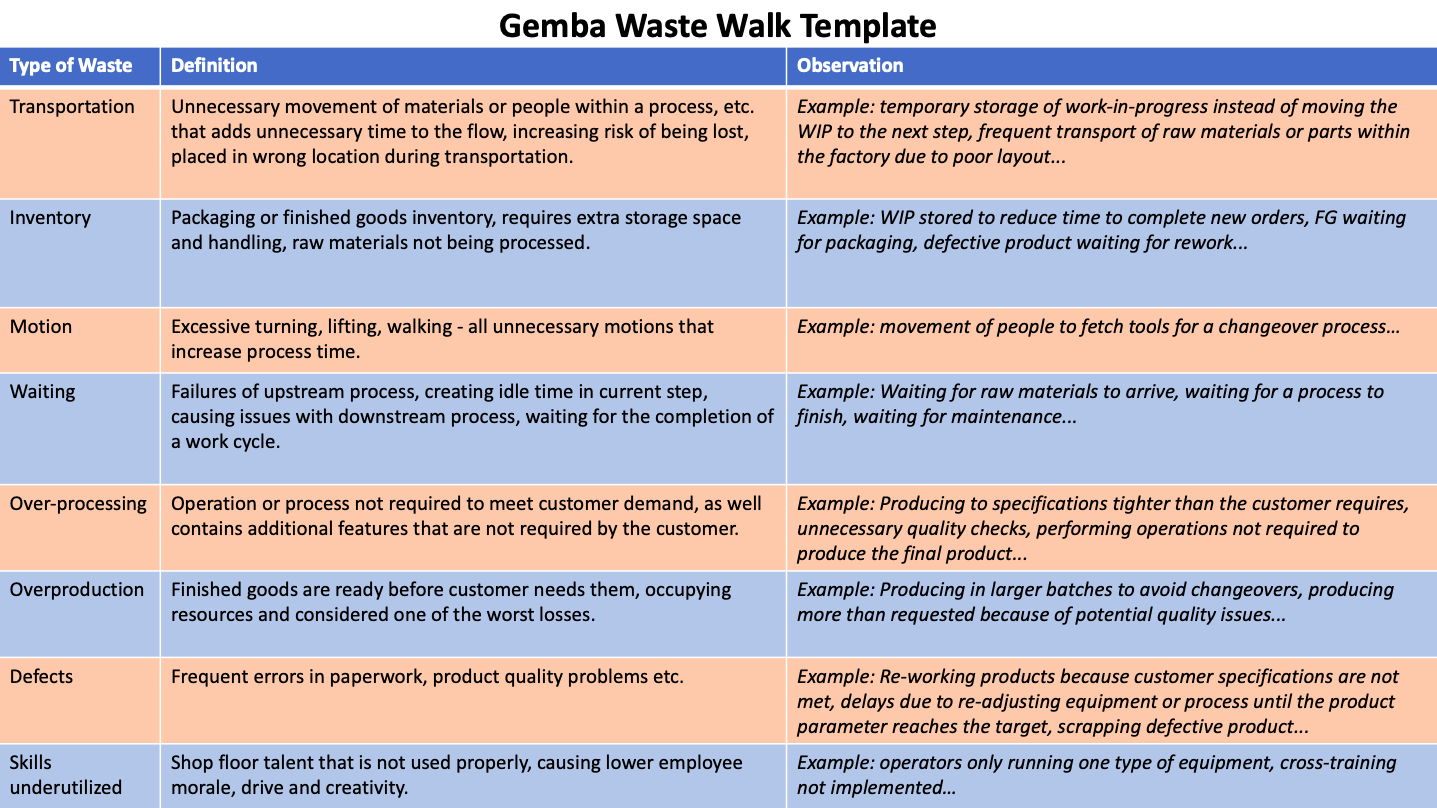The lean methodology defines eight forms of waste:
- Transportation
- Inventory
- Motion
- Waiting
- Over-processing
- Overproduction
- Defects
- Skills underutilized
Initially, seven wastes (Muda) were developed by Taiichi Ohno, the Chief Engineer at Toyota, as part of the Toyota Production System (TPS). The seven wastes were Transportation, Inventory, Motion, Waiting, Over-processing, Overproduction, and Defects. They are often referred to by the acronym ‘TIMWOOD’. The 8th waste of underutilized talent or ‘Skills’ of workers was later introduced in the 1990s when the Toyota Production System was adopted in the Western world. As a result, the eight wastes are commonly referred to as ‘TIMWOODS’. Here are all wastes in detail:
Transportation waste
Unnecessary movement of materials or people within a process adds unnecessary time to the flow, increasing the risk of being lost or placed in the wrong location during transportation.
- It can cause production delays, handling damage, and time for transportation is not contributing to output.
- Long transportation impacts communication, resulting in delays, and this can also affect product quality.
How to reduce transportation?
- Challenge the current layout and minimize material transportation from one function to another.
Inventory waste
Packaging or finished goods (FG) inventory requires extra storage space and handling, and raw materials are not being processed.
- Work in process (WIP) stored to reduce time to complete new orders, FG waiting for packaging, defective product waiting for rework…
Inventory’s Dark Side:
- Often a symptom of problems in the process is hidden behind rising stock levels.
- Increases operational costs, including conveyance, storage, and risk of obsolescence.
- Increases production lead time.
How to reduce inventory?
- Define necessary inventory levels and minimize by reducing batch sizes in production and limiting WIP.
Motion waste
Excessive turning, lifting, and walking – all unnecessary motions that increase process time. Unnecessary movement of people or machines within a process.
How to reduce wasted motion?
- Check: do manual and machine work cycles contain unnecessary motion elements?
- Check: are the tooling, equipment and parts around workstations optimized?
- Check: is the layout optimized for varying customer demands?
Waste of Waiting
Failures of the upstream process create idle time in the current step, causing issues with the downstream process. People or machines waiting for the completion of a work cycle.
How to reduce waiting?
- Check: does the machine need to be monitored? Are there built-in checks to stop the machine from producing defective products?
- Check: is the production line balanced so people and machines have minimal idle time?
- Check: can idle time be filled in other ways? (quality checks, cleaning, material handling….)
Over-processing waste
Operation or process not required to meet customer demand also contains additional features that the customer does not require.
- Over-processing often happens when standards are difficult to define (polishing, painting, etc.).
How to reduce over-processing?
- A clear understanding of the customer’s expectations and correct translation into specifications are followed by design and production.
Overproduction waste
Finished Goods are ready before the customer needs them, occupying resources and considered one of the worst losses. Producing sooner, faster, or in greater quantities than customer demand.
- Over-produced items end up as inventory or scrap, therefore creating other waste.
- Overproduction takes time away from value-added activities.
How to reduce overproduction?
- A clear understanding of the customer demand and producing only what the customer wants and when needed.
Defects waste
Rework generated due to damaged packaging, bad date code, or best before on FG, a product put on hold due to quality issues, resulting in lost sales or hidden costs. Producing product that does not meet specifications.
- Causes of defects: methods, materials, machines, manpower, environment
How to reduce defects?
- Improve process capability by analyzing and solving the root causes of the defects
Skills underutilized waste
- Shop floor talent that is not used correctly causes lower employee morale, drive and creativity.
Gemba Waste Walk Template
We just talked about eight sources of waste. Would you like to identify these at your manufacturing facility? Use our template while walking all areas, observe and note so it can be analyzed and actioned later.

A printable template can be downloaded here
Exercise:
- Create a presentation using training materials from this lesson
- Invite team members to a meeting
- Present the knowledge
- Explain how to use the form
- Go to Gemba (the actual place, for example, the production floor)
- Walk through all accessible areas and observe all wastes described in the form
- Take note of all wastes
- Return to the room and review the findings
- Brainstorm and come up with ideas on how to reduce/eliminate wastes

















